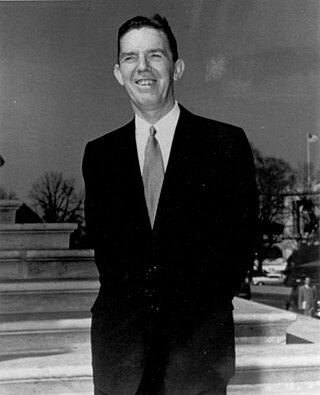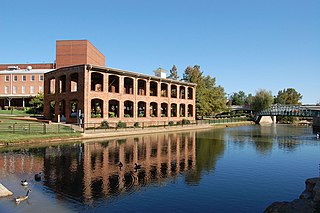
Seneca is a city in Oconee County, South Carolina, United States. The population was 8,102 at the 2010 census. It is the principal city of the Seneca Micropolitan Statistical Area, an (MSA) that includes all of Oconee County, and that is included within the greater Greenville-Spartanburg-Anderson, South Carolina Combined Statistical Area. Seneca was named for the nearby Cherokee town of Isunigu, which English colonists knew as "Seneca Town".

Pickens, formerly called Pickens Courthouse, is a city in and the county seat of Pickens County, South Carolina, United States. The population was 3,126 at the 2010 census. Pickens changed its classification from a town to a city in 1998, but it was not reported to the Census Bureau until 2001. It was named after Andrew Pickens (1739–1817), an American revolutionary soldier and US Congressman for South Carolina.

Clemson is a city in Pickens and Anderson counties in the U.S. state of South Carolina. Clemson is adjacent to Clemson University, and is identified with it; in 2015, the Princeton Review cited the town of Clemson as ranking #1 in the United States for "town-and-gown" relations with its resident university. The population of the city was 17,681 at the 2020 census.

Elias Earle was a United States representative from South Carolina. Born in Frederick County in the Colony of Virginia, he attended private school and moved to Greenville County, South Carolina, in September 1787. He was one of the earliest ironmasters of the South, and prospected and negotiated in the iron region of Georgia.

Thomas Albert Wofford was a United States senator from South Carolina. Born in Madden Station, Laurens County, South Carolina, he attended the public schools and graduated from the University of South Carolina at Columbia in 1928, and from Harvard University Law School in 1931. He was admitted to the bar in the latter year and commenced the practice of law in Greenville. He was assistant solicitor of the thirteenth judicial circuit from 1935 to 1936, and was assistant United States district attorney from 1937 to 1944.
Easley High School (EHS) is a public high school in Easley, South Carolina, founded in 1909. The original auditorium is on the National Register of Historic Places.

Table Rock State Park is a 3,083-acre (12.48 km2) park at the edge of the Blue Ridge Mountains in northern Pickens County, South Carolina. The park includes Pinnacle Mountain, the tallest mountain totally within the state.

The present Douglas County Courthouse is located at 1701 Farnam Street in Omaha, Nebraska, United States. Built in 1912, it was added to the National Register of Historic Places in 1979. Notable events at the courthouse include two lynchings and the city's first sit-in during the Civil Rights Movement. Five years after it was opened, the building was almost destroyed by mob violence in the Omaha Race Riot of 1919.

This is a list of the National Register of Historic Places listings in Greenville, South Carolina.
Dacusville is a small unincorporated community and census-designated place (CDP) in Pickens County, South Carolina, United States. It is best known for its tractor show once a year in the month of September. The community also has an elementary school and a middle school. It was first listed as a CDP in the 2020 census with a population of 399.

Hagood Mill is an operational water-powered gristmill built in 1845 by James Hagood near Pickens, South Carolina. It was listed in the National Register of Historic Places in 1972.

The Hagood-Mauldin House is a property listed on the National Register of Historic Places located in Pickens, South Carolina. The house was originally constructed for James Earle Hagood ca.1856 in the town of Old Pickens but in 1868 when the Pickens District was divided into Oconee County and Pickens County, the house was disassembled, boards and beams numbered, and reassembled at its present location in the town of Pickens.

Mount Hebron Temperance Hall, also known as Division Room of the Saludavill Division No. 47, Sons of Temperance and Division Room of the Mt. Hebron Division No. 7, Sons of Temperance, is a historic temperance hall located at West Columbia, Lexington County, South Carolina. It was built in 1862, and is a small, one-story rectangular frame building. It is sheathed in weatherboard and has a gable roof. The building originally housed local chapters of the Sons of Temperance. It was restored in 1979, and is located in the churchyard of the Mount Hebron United Methodist Church. The church uses it as a Sunday School building and Boy Scout Hut.

Lee and Lowry Hall, originally known as the Structural Science Building, is a historic academic building located on the campus of Clemson University, Clemson, Pickens County, South Carolina. It was designed by Harlan Ewart McClure, Dean of the College of Architecture, and completed in 1958. It consists of three building elements that enclose two courtyards: the Civil Engineering Wing, the Mechanical Engineering Laboratories, and the Architecture Wing. The buildings are in the International Style.

Earle Town House is a historic house in Greenville, South Carolina. It was listed in the National Register of Historic Places on August 5, 1969, and is included in the Col. Elias Earle Historic District.

Whitehall is a historic home located at Greenville, South Carolina. It was built in 1813 as a summer residence by Charlestonian Henry Middleton on land purchased from Elias Earle. Whitehall served as Middleton's summer home until 1820. It is a simple white frame structure with shuttered windows and wide first and second story galleries, or piazzas, in the Barbadian style.

Greenville County Courthouse, also known as Greenville Family Courts Building, is a historic courthouse located at Greenville, South Carolina. It was built in 1918, and is a Beaux-Arts style brick and concrete building with terra cotta trim. The building consists of a three-story front section, with an eight-story tower behind. The building served as the courthouse for Greenville County until 1950 when the court was moved to a new building. The Family Court of Greenville County was located then in the building and remained there until 1991.

Col. Elias Earle Historic District is a national historic district located at Greenville, South Carolina. It encompasses 74 contributing buildings in a middle-class neighborhood of Greenville. The houses primarily date from about 1915 to 1930, and include Neoclassical, Colonial Revival, Tudor Revival, and bungalow styles. The district was originally part of the estate of Colonel Elias Earle, a prominent early-19th century Greenville citizen. The Earle St. Baptist Church is located in the district.
The lynching of Willie Earle took place in Greenville, South Carolina on February 16, 1947, when Willie Earle, a 24-year-old black man, was arrested, taken from his jail cell and murdered. It is considered the last racially motivated lynching to occur in South Carolina. The subsequent trial gained much media attention, and was covered by Rebecca West for The New Yorker. The trial resulted in the acquittal of 31 white men who had been charged with Earle's murder.

The Wyche Pavilion is the two-story, open-air shell of a historic building in downtown Greenville, South Carolina, used in the 21st century as an event venue. As part of the Reedy River Industrial District, the building was listed in the National Register of Historic Places on January 14, 1979.




















